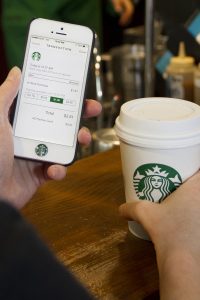In four years, the Starbucks mobile-payment service, Apple Pay, Google Pay, and Samsung Pay, will continue to garner large shares of users, but not as much as they do today. That’s the forecast from research firm eMarketer Inc., released Tuesday.
Of the four major mobile-payments services, Starbucks Corp.’s app will continue to be the most popular, with 29.8 million users by 2022, a 27.4% increase from 23.4 million users in 2018.
Similarly, Apple Inc.’s Apple Pay users will increase to 27.5 million by 2022 from 22 million, a predicted 25% increase. The number of Google Pay users is forecast to reach 14.9 million in four years, up 34.2% from 11.1 million. Samsung Pay’s user base will be 13.2 million, a 33.3% increase from 9.9 million in 2018.
EMarketer predicts that while the Starbucks mobile-payment service will continue to dominate—it has an estimated 42.6% of proximity mobile payment users now—by 2022 that will decrease to 39.8%. Apple Pay will go from 39.9% to 36.8%. Google Pay and Samsung Pay are forecast to decrease, too, but at smaller rates.
The expectation, eMarketer says, is that new payments apps will take market share from the four that are dominant today. “Retailers are increasingly creating their own payment apps, which allow them to capture valuable data about their users. They can also build in rewards and perks to boost customer loyalty,” Cindy Liu, eMarketer forecasting analyst, said in a press release.
Merchants offering their own payment apps include chain powerhouses Walmart, Kohl’s, and CVS.
EMarketer also says that more than 25% of U.S. smart-phone users ages 14 and older will make a proximity mobile payments at least once every six months in 2018. The number of these users will reach 55 million in 2018.






